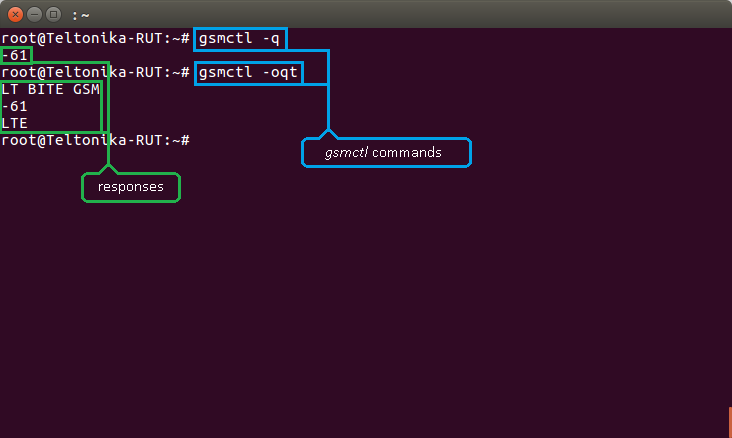AT Commands
AT commands ("AT" meaning 'attention') are instructions used to control a modem.
Summary
The command set consists of a series of short text strings which can be combined to produce commands for operations such as dialing, managing SMS functions, and changing the parameters of the connection. Many of the commands that are used to control wired dial-up modems, such as ATD (Dial), ATA (Answer), ATH (Hook control) and ATO (Return to online data state), are also supported by GSM/GPRS modems and mobile phones. This section is an overview of some AT commands that can be used with RUT routers.
gsmctl commands
gsmctl is a set of shell commands that can request information from or perform operations on a modem. In other words, gsmctl is a way to use AT commands in shell form. You can use them via SSH or CLI, the command line interface that can be used via the router's WebUI.
SSH
To log in to a RUT router via SSH, download the free PuTTY app if you're using Windows; if you're using a Linux based OS, just use the Terminal app. In both cases you will need to know three things: the router's LAN IP address, user name and password. The default LAN IP address for all RUT routers is 192.168.1.1; the default log in information is username: root; password: admin01 (NOTE: the user name used for SSH connections (i.e., root) is not the same as the user name used to log in to the router's WebUI (i.e., admin)).
If you're using PuTTY, enter the router's LAN IP address into the Host Name (or IP address) field, select SSH Connection type and click Open. After this you will be prompted to enter the user name and password.
If you're using Linux, open a Terminal and type this command:
# ssh [email protected]
If you made changes to LAN IP address or log in name, replace the relevant data in the command above so that it is correct for your specific case. After executing this command you will prompted to enter the router's admin password.
Usage
The syntax for a gsmctl command is gsmctl OPTIONS. A list possible gsmctl options is provided below:
-p, --ip <INTERFACE> Get IP of logical interface -e, --bsent <INTERFACE> Get number of bytes sent -r, --brecv <INTERFACE> Get number of bytes recieved -j, --connstate Get 3G connection state -g, --netstate Get network link state -i, --imei Get device IMEI -J, --iccid Get SIM ICCID -m, --model Get device model -w, --manuf Get device manufacturer -a, --serial Get device serial number -y, --revision Get device revision number -x, --imsi Get IMSI -z, --simstate Get SIM card state -u, --pinstate Get PIN state -q, --signal Get GSM signal level -X, --rscp Get WCDMA rscp level -E, --ecio Get WCDMA ec/io level -W, --rsrp Get LTE rsrp level -Z, --sinr Get LTE sinr level -M, --rsrq Get LTE rsrq level -C, --cellid Get cell id parameter -o, --operator Get name of operator used -f, --opernum Get operator number -t, --conntype Get data carrier type -c, --temp Get module temperature in 0.1 degrees Celcius -B, --pincount Get pin/puk count -F --network Get network information -K --serving Get serving cell information -I --neighbour Get neighbour cell information -D, --shutdown Shutdown the modem -h, --help Prints this information -v, --version Print version
sms managing options: -S -r, --sms --read <INDEX> Read SMS by index -S -l, --sms --list <TYPE> List SMS by type [all, read, new] -S -t, --sms --total Print SMS memory usage -S -d, --sms --delete <INDEX> Delete SMS by index -S -s, --sms --send "<NUMBER> <TEXT>" Send SMS. IMPORTANT! Number and text must be within quotes -S -b, --sms --send-b64 <NUMBER> Send SMS encoded in base64 from /tmp/.smstext
compatibility options: -N, --he910 Support for Telit HE910-EUD -R, --em820w Support for Huawei EM820W -U, --me909u Support for Huawei LTE ME909u -V, --le910 Support for Telit LE910
auxiliary options: -A, --at <COMMAND> Send AT command to device -H, --shell Enter shell mode -k, --debug Enable debug information -n, --nolog Do not log the command
You can view this list via terminal by typing gsmctl -h or gsmctl --help.
For example, try using gsmctl -q to get the current RSSI value in dBm. You can also combine options. For example, gsmctl -oqt:
Unlike gsmctl -q, gsmctl -oqt returns three options: operator's name, signal quality level and carrier type, as you can see in the example above.
AT command usage
To use a specific AT command via SSH, you can use the gsmctl -H. After this your console will enter shell mode where you can then just type AT commands in their regular format. Or you can use gsmctl -A <AT_COMMAND> to execute AT commands one at a time.
External links
PuTTY download - https://www.putty.org/

